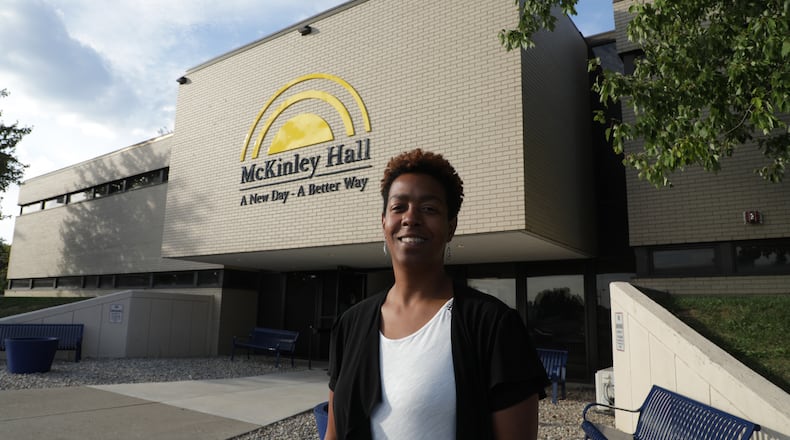Champaign County ranked No. 14 in the state in 2014, but since has seen a decline compared to the state, dropping to No. 50 by 2019.
Neighboring Montgomery County ranked first in the state for the most overdose deaths per 100,000 residents in 2014, 2016 and 2017, but fell out of the top 10 in 2020 and 2021, according to ODH.
The statistics from the most recent years are unofficial and work remains to be done to stop overdose deaths, local health department officials warn.
According to the CDC’s Provisional Drug Overdose Death statistics, the number of deaths from March 2020-21 has risen more than 30% across the United States compared to March 2019-20. In Ohio, the CDC stats show a 26% increase in overdose deaths.
Officials have said the reasons behind the increases nationwide might have to do with the added stresses created by the COVID-19 pandemic, and difficulty getting rehabilitative services during lockdowns and social distancing requirements.
Wendy Doolittle, CEO of McKinley Hall, said the pandemic has had multiple impacts on patients of the Springfield-based rehabilitation center. For some patients, the hurdle of isolation was difficult to surpass. Many 12-step programs were put on hold in 2020 due to COVID-19 precautions, and people seeking a support network through programming that pivoted to digital platforms lacked the engagement one can get through face-to-face interactions, she said.
Doolittle also said that the pandemic impacted the rehabilitation center’s access to a particularly vulnerable population: people coming out of incarceration. McKinley Hall workers would go to Clark County Jail to teach at-risk inmates how to use Naloxone, also called Narcan, which can reverse the effects of an opioid overdose. Deputies then would place Narcan kits among the belongings of inmates leaving the jail after completing their sentences.
“When we think about overdose death prevention, we think about harm reduction in general,” Doolittle said.
In addition, an unintentional outcome of stimulus money was an increase in patients leaving the rehabilitation center’s residential programming against medical advice, Doolittle said.
“I think we witnessed a lot of lives leave Clark County, leave the earth, as a result of that stimulus money being mismanaged by a person with a substance use disorder,” she said.
The CEO said that multiple patients who were in the early stages of their recovery, beginning to gain stability, left programming after their stimulus payment came in.
“They would leave the program ... and we did have a few people who ended up deceased shortly thereafter,” she said. “Many people go on to leave normal lives and are able to manage their resources, but so early in recovery, it’s a trigger to have that kind of money sitting in your bank account. We definitely witnessed the negative consequences of that, for many people.”
What’s working?
In 2017, Montgomery County reported more than 500 accidental overdose deaths, while Clark reported 96 and Champaign reported 17. National and international news crews came to the Dayton area to report what was going on, said Dennis Cauchon, president of Harm Reduction Ohio, a nonprofit that tracks statewide overdose statistics. Officials were forced to mobilize to get it under control.
In 2019, 266 deaths were reported in Montgomery County, with the accidental overdose deaths ticking up to 309 in 2020 during the pandemic.
“Likely the decline is related to a very aggressive and fairly well-organized effort to distribute naloxone, to expand syringe programs, coming into contact with those in active use who might die,” said Cauchon.
In Clark County, unintentional overdose death totals remained somewhat the same, with 56 deaths reported in 2019 and 55 deaths reported in 2020, state data shows. In Champaign County, deaths doubled locally, going from eight in 2019 to 16 in 2020.
Doolittle said Narcan distribution is a major component of McKinley Hall’s outreach programming and prevention efforts, with kits dispersed during community events and distributed through the Partners of Prevention coalition’s Get Recovery Options Working (GROW) program, a partnership among community organizations and government offices to tackle substance use in Clark County.
GROW involves prevention coordinators going door-to-door in at-risk neighborhoods to provide residents with packets of information about substance use disorders and to offer Narcan kit training.
The rehabilitation center has also partnered with community organizations like Secondhand Harvest to coordinate syringe exchange programs, which takes thousands of contaminated syringes out of circulation each month, Doolittle said. These syringe exchanges take place alongside food distributions, COVID-19 vaccinations and STD testing.
“The goal is to remove barriers so people have an opportunity to get well and stay well and not return to substance use,” Doolittle said, “but for those who have not gotten to that point, let’s figure out how it can be done in the safest way possible where it doesn’t harm the community as a whole.”
Still work to be done
The data kept by the Ohio Department of Health and local health districts have different overdose death totals because they are not calculated the same way. The local health districts count all overdose deaths that took place in their counties, while the state only counts residents of the county, officials said. Also, coroners across the state have several months to report their final totals, so all data should be considered preliminary.
As of Dec. 1, the Ohio Department of Health reports that Clark County has had 63 deaths while the Clark County Combined Health District is reporting 67. Champaign County’s numbers mirrored state figures, with eight deaths reported this year.
Carey McKee, who works as a prevention coordinator and McKinley Hall and the coordinator of the Partners of Prevention coalition, said that education is crucial in terms of prevention.
The rehabilitation center has been working on evidence-based education for youth in regard to substance use, with an emphasis on vaping, which McKee said was the “main substance of choice.” Another campaign will also focus on alcohol sales among underaged people, working with retailers to train employees and to implement signage.
McKee said that 90% of individuals who have a substance abuse disorder who utilize McKinley Hall for services began using substances before the age of 18.
“You have to incorporate good prevention programming and messaging around the harmful effects of substance use,” Doolittle said. “Get to the source and start teaching youth early on.”
By the Numbers:
67: Unintentional overdose deaths reported in Clark County this year
8: Unintentional overdose deaths reported in Champaign County this year
12: The rank of Clark County in terms of overdose deaths per 100,000 residents this year


